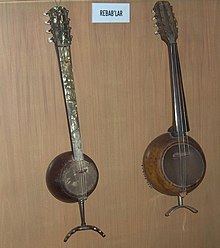Rebab
Rabāb, also rabab, rebab, rbab, rababa and similar spellings (Arabic رباب, DMG rabāb), refers to bowed lute instruments often with a round or rectangular soundbox, one to three strings and a soundboard of animal skin, which are widespread from the Maghreb in North Africa through the Arab countries of the Middle East, Turkey, Iran to Southeast Asia. In South Asia and Central Asia the word rabāb stands for plucked long-necked lute.
The rabāb reached Central Europe via Spain and Sicily, and here in the 13th century it inspired the rebec, one of the most important stringed instruments of the Middle Ages. In medieval North Africa the rebāb andalūsī was similarly popular to the Oriental short-necked lute ʿūd. Despite its limited range of just over an octave, the rebab became a popular instrument of light music in the Ottoman Empire. There are similarities to the slightly longer bowed lute kamantsche played in Iranian music.
The rabāb should not be confused with the rubāb found in Afghanistan, a plucked instrument with about 19 strings and a double body. The rubab has evolved into the plucked Iranian long-necked tar lute with a double soundbox. The rabāb played in India during the Mughal period was a five-stringed plucked long-necked lute with a round body, which was replaced by the sursingar in the 19th century.
In various Arab and Central Asian countries as far away as China there are other stringed instruments, developed from the Arabic consonant root r-b-b, under names such as rawap among the Uighurs and rebab, rubab, robab and rababah; most Central Asian ones are related to the Afghan model. Their range extends from the one-stringed bowed box spit lute ribab of the Moroccan Rwais Berbers in the west to the Southeast Asian spiked fiddle rebab with a small round soundbox and three strings, which occurs in Indonesia as far east as the Muslim music of Lombok.
In Sudan, rabāb or rabāba is a common alternative name of the shell lyre tanbura.

Turkish rebap in the Mevlana Museum in Konya
Search within the encyclopedia